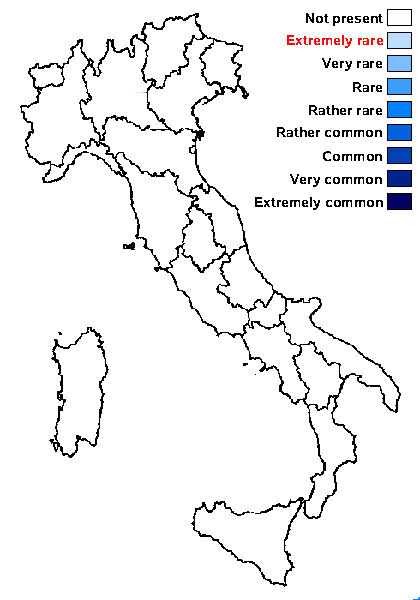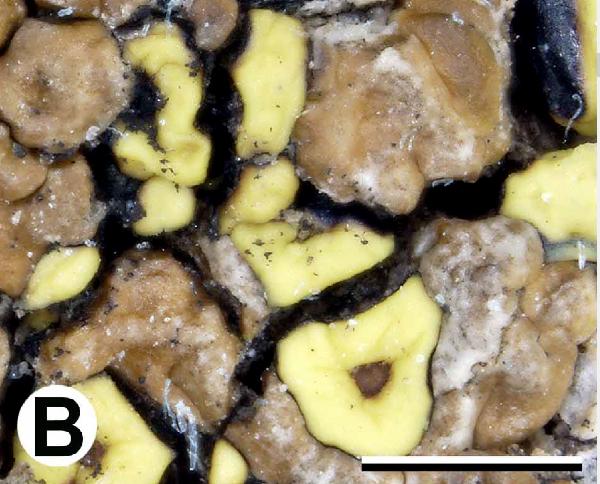Acarospora flavisparsa V.J. Rico & Candan
in Lumbsch & al., Phytotaxa, 18: 9, 2011.
Synonyms:
Distribution:
Description: Thallus crustose, episubstratic, bright to pale yellow or greenish yellow, areolate to subsquamulose, consisting of dispersed patches of one to few areoles on the thalli of Protoparmelia montagnei , more rarely of Dimelaena oreina. Areoles rounded to angular by mutual compression, concave to convex, sometimes lobulate or fissured, 0.5-3.5 mm wide, up to 2.25 mm thick, commonly forming a short stipe and becoming subsquamulose, the margins and lower surface yellow-brown to carbonized black. Upper cortex paraplectenchymatous, (35-)40-125 μm thick, the cells usually indistinct, subglobose, arranged in several layers, the upper ones brown-yellow, the lower ones hyaline; lateral lower cortex with brown to usually carbonized black upper layers; algal layer continuous, up to 200 μm thick; medulla dirty white. Apothecia immersed, aspicilioid, up to 0.7 mm across, 1-8 per areole, sometimes confluent, punctiform to round or irregular, with a brown to red-brown, concave to flat, rough disc. Proper exciple cupular, surrounded by algae, ± prosoplectenchymatous, 12-30 μm wide, hyaline to yellowish; epithecium brownish, with yellowish granules, up to 20 μm high; hymenium colourless to yellowish, 125-250(-300) μm high; paraphyses 1.5-3 μm thick at base, the slightly pigmented apical cells up to 4.5 μm wide; hypothecium, including the subhymenium, colourless to slightly yellowish, up to 150 μm thick. Asci > 100-spored, clavate, the outer wall K/I+ blue, the tholus K/I-. Ascospores 1-celled, hyaline, elongate to cylindrical, 4-7.5 x 1.5-3.5 μm. Pycnidia immersed, punctiform, subglobose, up to 210 μm across, the wall hyaline to yellowish, surrounded by algae. Conidia hyaline, bacilliform, 2.5-5 x 1-2 μm. Photobiont chlorococcoid. Spot tests: cortex and medulla K-, C-, KC-, P-, I-; cortex UV ± orange. Chemistry: epanorin (major), with or without rhizocarpic acid (traces). Note: known from continental Mediterranean areas in the Iberian Peninsula, where it occurs on acid rocks in inland areas, between 550 and 1500 m, on exposed, more or less vertical rock walls, in association with Protoparmelia montagnei, more rarely with Dimelaena oreina, this species should be looked for in Mediterranean Italy, especially in the central parts of Sardinia.
Growth form: Crustose
Substrata: rocks
Photobiont: green algae other than Trentepohlia
Reproductive strategy: mainly sexual
paras Protoparmelia montagnei and Dimeleaena oreina

Predictive model

V. J. Rico - Univ. Complutense, Madrid
SPAIN. Madrid: Sán Lorenzo de El Escorial, near Silla de Felipe II, 40º 35’N, 04º 09’W, 1080 m, associated with Protoparmelia montagnei on granite, July 1986, Florido & Rico 1133/1 (holotype MAF-Lich. 16463).
Detail of squamules with apothecia, showing dark lateral surface (photograph V. J. Rico).
Growth form: Crustose
Substrata: rocks
Photobiont: green algae other than Trentepohlia
Reproductive strategy: mainly sexual
paras Protoparmelia montagnei and Dimeleaena oreina

Predictive model


